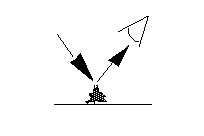
2.5 Energy Interactions with the Earth Surface
What will happen when the EM energy reaches the Earth surface? The answer is that the total energy will be broken into three parts: reflected, absorbed, and/or transmitted.
r, a and t change from one matter to another.
t has been mentioned earlier. Solar energy has to transfer through the atmosphere in order to reach the Earth surface. Transmitted energy can also be measured from under water.
At the thermal spectral region, energy is primarily absorbed, and the reflected energy is significantly less in magnitude than the emission of a target. Since what is absorbed will be emitted, the absorbance "a" or the emissivity "
" is a parameter of concern in the thermal region.
r is the easiest to measure using remote sensing devices. Therefore, it is the most important parameter for remote sensing observation using the 0.3 - 2.5 Ám. r is called spectral reflectance or reflectance or spectral signature.

Our second question is: how is energy reflected by a target? It can be classified into three cases, specular reflector, irregular reflector, and perfect diffusor.
Specular reflector is caused by the surface geometry of a mater. It is of little use in remote sensing because the incoming energy is completely reflected in another direction. Still water, ice and many other minerals with crystal surfaces have the same property.
Perfect diffuse reflector refers to a matter which reflects energy uniformly to all directions. This type of reflector is desirable because it is possible to observe the matter at any direction and obtain the same reflectance.
Unfortunately most targets have a behaviour between the ideal specular reflector and diffuse reflector. This makes quantitative remote sensing and target identification purely from reflectance data difficult. Otherwise, it would be easy to discriminate object using spectral reflectances from a spectral library. Due to the variability of spectral signature, one of the current research direction is to investigate the bidirectional properties of various targets.
Plotting reflectance against wavelength, we will get a spectral reflectance curve. Examples of spectral curves of typical materials such as vegetation, soil and water are shown in Figure 2.5. Clear water has a low spectral reflectance (< 10%) in the visible region. At wavelengths longer than 0.75 Ám, water absorbs almost all the incoming energy. Vegetation generally has three reflectance valleys. The one at the red spectral wavelength region (0.65 Ám) is caused by high absorptance of energy by chloraphyll a and b in the leaves. The other two at 1.45-1.55 Ám and 1.90-1.95 Ám are caused by high absorptance of energy by water in the leaves. Dry soil has a relatively flat reflectance curve. When it is wet, its spectral reflectance drops due to water absorption.
Figure 2.5 Typical Spectral Reflectance Curves for Soil, Vegetation and Water
(Lillesand and Kiefer, 1994)